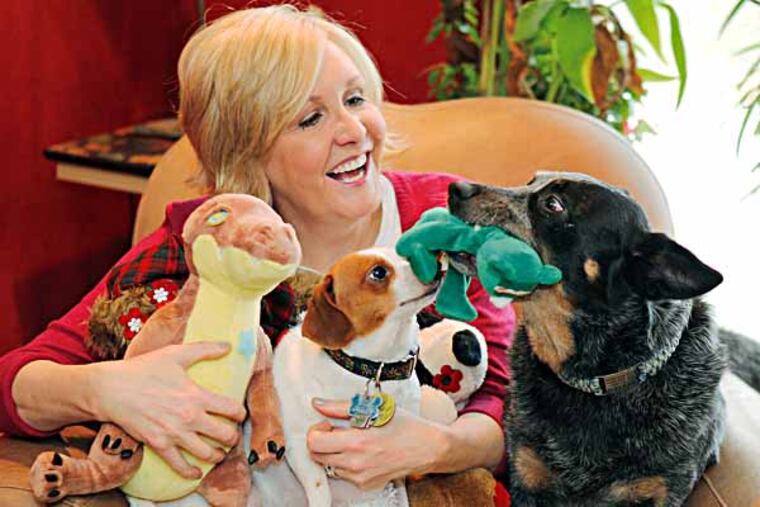Old toys become pet fun and promote spaying, neutering
Dexter, a purebred Australian cattle dog, gnawed on a stuffed animal until he found the sweet spot that made the toy squeak.

Dexter, a purebred Australian cattle dog, gnawed on a stuffed animal until he found the sweet spot that made the toy squeak.
"They love that squeaker," Marianne Ahern said this month as Dexter and two other four-legged creatures played with the squeaky item at her half-acre house near Langhorne, Bucks County.
The toy was originally a Beanie Baby that would have ended up in a landfill, but Ahern reclaimed it, cleaned it, and converted it into a Glad Dogs Nation product.
"I see this as my retirement business," said Ahern, 57, president and founder of Glad Dogs Nation.
Since incorporating the company in January, Ahern has been taking used children's toys and up-cycling them into playthings for pets. She makes the toys at her home and sells them at dog expos and online at GladDogsNation.com for as low as $3.
By early December, Ahern said, she had sold more than 1,100 of the toys.
She has pledged to donate a share of her profit to causes and groups that promote the spaying and neutering of pets, a small step she hopes will help offset the widespread euthanasia of shelter animals. This fall, Ahern said, she gave several hundred dollars to a local SPCA.
"I'm trying to cut down on that devastation," she said.
From six million to eight million homeless cats and dogs enter animal shelters every year, and about half are put to death, according to the Humane Society of the United States. The vast majority of those animals have not been spayed or neutered.
Ray Little, lifesaving director of Philadelphia's Operation Ava animal shelter, said spaying and neutering "is a great way to end suffering for these animals."
The procedure has no adverse health effects on animals and has benefits beyond controlling overpopulation, according to Little. He said neutering eliminates a male dog's desire to run away to mate and diminishes a male dog's instinct to urinate on property as a way of marking its territory.
Ahern also runs a marketing firm and makes occasional guest appearances on the QVC home-shopping network. And she fosters dogs, a passion she has been indulging since moving about nine years ago to Lower Southampton from Trenton.
During that span, more than 90 dogs have lived at Ahern's home for weeks or months before being adopted out to permanent households, she said.
Dexter, 9, was one of Ahern's first foster dogs, and she decided to keep him, she said, after nursing him to good health "from the brink of death."
But simply giving the dogs a temporary place to live is not enough, she said. "It's not changing the core problem" of sheltered animals' being euthanized, Ahern said, "and that's what was getting me mad."
Ahern has several volunteers like Elaine Ibach, 61, of Burlington County, who help her make stuffed animals into pet toys.
"It fills my time and it doesn't take much, a couple of hours while I watch television," said Ibach, a recently retired accountant.
Ibach uses small scissors to cut open the midsection to remove beans and inserts a squeaker into the stuffed animal. She sews up the belly and then removes the eyes and nose to sew on appliqués in their place, reducing the choking hazard.
"I've done a couple hundred since starting," Ibach said Wednesday. "The supplies to make them into toys are cheap, and it costs almost nothing to do it. And it's for a good cause."
Used stuffed animals are not accepted by most thrift stores because of concerns the toys may be infested with lice or bedbugs, said Ahern.
This month, Ahern's garage was crowded with black trash bags stashed on top of each other, all filled with donated stuffed animals.
"It's a sacrifice you have to make," said Ahern's husband, Layne Brown, 49. "I can't put stuff in my garage anymore, but that's OK. It's well worth it."